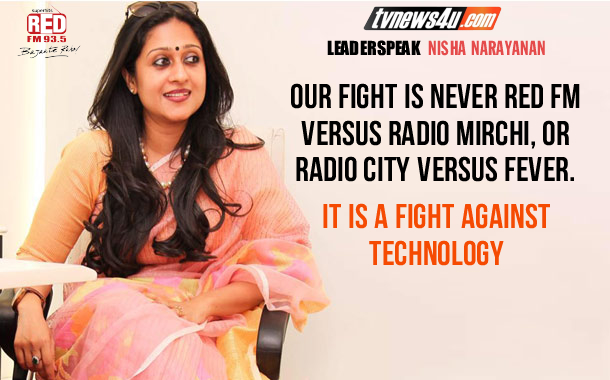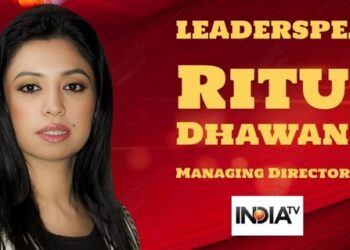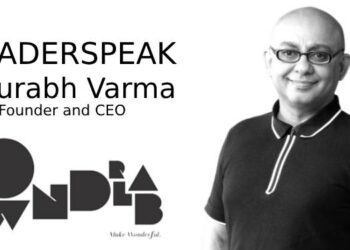She always thought she’d have a career in pure finance, but the first chance she got for a break during the mugging for an economics exam, she went on impulse and auditioned for a radio presenter opening at AIR in the pre-private FM networks days. And ever since the first show she presented thereafter, Nisha Narayanan, consumed by a love for media and entertainment, became a Chevening Scholar in Journalism and has had a high-achievement career across television and now for 24 long years, in her first love in M&E, Radio.
We caught up with Nisha Narayanan, COO of Red FM, India’s popular, free-spirited, straight-talking network on an entertainment-driven mission of questioning the defaulters and entertaining the nation with its great mix of Bajaate Raho entertainment. It was a free-wheeling conversation about Nisha’s journey in media and about her first love, Radio, what drives the medium, why it is important for FM Radio to grow more verticals and remain ahead of the curve, and about the challenges and opportunities in FM Phase III and more. Excerpts.
If I bumped into you for the first time, and asked you about yourself, what would you say?
Nisha Narayanan: I work for a network of radio stations called Red FM (laughs). No, if I were to be speaking more seriously, I think I’d just say I’m a media professional and definitely a maverick who loves radio and who believes in the medium and who is here to enjoy the medium. Yeah, that’s it.
Okay. And early influences, education — what it was like, where did you grow up, what were your sources of entertainment…? Briefly?
I come from a service background. My father was in the Navy, so we used to travel to different cities … we would keep getting posted. I was studying economics and I was actually listening to the radio once and they were calling for RJs. I think I had my economics exams the next day. I was so bored and fried studying and I couldn’t finish mugging up, so out of the blue, in the middle of my exams, I just thought of applying. I mean, I had no ambition of joining the media — no ambition of getting into the media in any form. I was thinking of finance and getting into finance in a much more serious way as a profession. But I applied, and they called me for an RJ’s audition. It was All India Radio Delhi, and those were the days when there was no private FM. And there I was, applying to be an RJ! They called me for an audition, and I was selected, did my first show, and there began the journey.

So finance was the conventionally good-to-enter career, but you discovered Radio and began to enjoy the media side of things…?
Yes. And parallely studies were going on, but I was much attracted to Journalism and Radio and Television. I dabbled with a lot of it, and was a documentary film-maker. I’m a Chevening Scholar, did my Journalism, and was doing news and current affairs for Television for a long time.
But I think Radio was my first love, so I went back to radio, and have been in radio for quite some time now. About 24 years. And I’ve been with Red FM for a decade now.

How important is a forte for content in what you do?
As long as you understand the medium and the power of the medium which is FM, and the fact that it is local in nature and therefore so vibrantly different across cities just because of the local flavor… like when you travel across a Shillong to a Jabalpur to a Rajamundhri to any other, each city has a different flavour, and you’re opening up the airways to reflect the local flavour of that city through humour, interactions and entertainment, you’ve got the ball rolling.
I think the greater need is to understand the power of the medium and to allow it to flourish in that city. So focus on the things that are local, and that itself is so rich! Each city has its own character and personality – which comes from its people, their dialects and their humour and the way they interact with one another… If you’re able to grab that and if you are somewhere able to reflect that on radio, you’ll do great. You know the business. We are in the business of entertainment and if we can do that uniquely when we begin in any new city, I think we’ve done half the job there.
How involved are you in the recruitment process? Senior levels, of course you would meet and approve, but what about the entry level youngsters? Do you meet them, and what’s the experience like? What do you learn from these fresh new aspirants?
Oh, a lot. Those who come for middle and senior roles, well, they’re already in the industry so you know they come with certain experience, but what I really like and enjoy doing, is meeting completely fresh students or people who come from outside the media and entertainment industry – they’re brimming with ideas, and especially the youngsters are far more exposed to the technology around them. By technology I mean the way digital and social media are ruling their lives, and the way they consume and exchange information through different platforms.

So you get a lot of ideas when you meet them – they’re fresh, they’re confident and passionate about their ideas. And not only do you spot talent, you also get to learn. I’ve never come out of a meeting with freshers without learning something from them. It could be anything – it could be their way of looking at things, their attitude to life, their perception about things around them, about what India is today and where they think it is going, what it needs. They’re the future, and they’re a very big audience on digital and social. Most important – they’re a fount of new ideas. Their perspective is very different, good and very fresh.
That’s a challenge in the industry today, isn’t it? Original and fresh thinking?
Yes, I think that’s the challenge when you are in the industry for a long time as different Radio channel brands, and when regulations don’t really allow you to go beyond the limit by using news and current affairs or anything, you are restricted. So the only way we can keep ourselves relevant in the consumers’ or the listeners’ eyes is by being entertaining and relevant and fresh, and being innovative. So these are things that fresh talent brings along. The challenge is they are a little scared in the beginning to open up and speak their minds, so you will find a little caution initially. Once they become a bit free there’s a lot they can and do bring in.
So you’re a radio network that’s lived its base line like perhaps none other, and you’re raring for Phase III of FM to roll out full steam ahead. What is impeding this rollout? What would help it?
One challenge is at the infrastructure setup level at a CTI level that is managed by BECIL.
How has Red FM been trying to retain, attract and grow talent?
Red FM is perhaps the first radio player that started working on the brand personality of the jocks. A fit for Red is not an easy find, however this is a challenge my HR team does manage well. With Red the brand fuels the jocks’ personality and vice versa, plus the empowerment at every level is a factor.
So ultimately, how many stations will Red FM have, nationwide?
Around 57.
… and talent will remain the perpetual challenge for all networks?
Yes, it always is. But the industry has come a long way – we’ve rolled out and run stations successfully. And radio attracts talent from every kind of sector. We’ve had people who are aeronautical engineers, people from coffee shops, actors, people from the textile industry, F&B… Most of them have left interesting jobs and even little industries to come and join radio. When they join, they’re not so sure if they can take it up as a job, so they take it up as a hobby. But once they got into it, they love what they do, because it is very creative in nature, and very response-driven.
To answer your specific question, within the industry, Red is arguably the most sought after place for an internship. There we get to spot raw talents whom we’ll hire and train. And even if we don’t send out one good middle level leader to set up a new team for a new station, we do have a fairly good team of people still across the length and breadth of the country, which we can always utilize to get into the newer markets. But while they might be guiding forces, while they might be training, the emphasis has to be on building a good team with seniors working with good trainees, and crucially, the talent must come from the local market, from amongst the local people.
What other likely challenges in Phase III?
Another critical piece is to also grow new markets from a business point of view. It is critical to grow local ad revenues, because every new radio channel that’s coming into a city for the first time will have to fight with two or three other channels that have been there for the previous 7 or 8 years. The retail radio ad revenue pie in those markets is quite small. And then, of course, the setting up and the content innovations. These are not challenges but opportunities, and we have to approach them positively, in that spirit.
And what is happening on the royalties front? What in your view would be ideal situation on the royalties? It’s a very lopsided space right now, and has been for some time. There is one music publisher which has its own deals with radio networks… So what is good, what is bad, what is ideal for radio in your view, speaking for radio as a medium?
I think we need to follow some of the international best practices that have already been there, like a certain percentage of the profitability from the revenues. That should be our way forward. We are pursuing this through AROI as this is a challenge for the industry. If this happens then it will allow the music to be played out in a more balanced way. There was a phase when we saw monopolistic trends in the music industry thereby causing a situation to play out only one particular label’s music.

Let’s talk about the standard of advertising on Radio. Generalizations are bad, but radio advertising does seem to be mostly humour, and perhaps audio tracks from major TV campaigns playing out. Also, your view on the quality of the advertising on radio. It seems to still be suffering. Is that perhaps because at most agencies, only the junior-most executive is put on radio?
I think there are much better ads coming out on radio. And in fact yes, most of those ads are being created not solely by the agency, but in large part by our in-house creative teams that work with clients for campaigns on their networks.
This is because they (the in-house creative teams) are immersed in the medium and are far more innovative with their ideas. I think there have been some very memorable campaigns created. Speaking for ourselves, campaigns like OLX and Vodafone Super fan.
We have specialist teams that work very closely with the clients and creative agencies and are coming up with some fabulous creative and winning awards. We live and breathe the medium so I think we understand how we can impact the ROI. So there are creative teams in-house — not just with Red FM, but across all the radio companies.
So there is innovation and I think the ads have become much better then the era where the radio jingle was a takedown of the TVC audio.
How important is digital in your scheme of things?
It’s one of the most critical things that we just cannot ignore. With digital we as a content house are moving towards platform-agnostic content production. Now my listeners can also consume Red on other platforms. Our fight is never Red FM versus Radio Mirchi or Radio City or Fever; it is a fight against technology and the constant challenge we face to adjust with the trends in a connected world. I believe FM Radio together is fighting against technology, which is providing newer platforms of content delivery. To remain relevant, we need to use digital and the first step that the industry should take up with the music label is an affordable non-interactive music royalty as an add on.

So Digital expands Radio’s personality and its audience-reaching avenues…
Yes. And the good part about the current FM Radio scene in India is that while music is extremely integral, it is not just the music that is driving the radio station. It is the content behind the music — the RJ, the humour, the characters, the network personality. It is the theatre that you built that is actually driving the radio stations.
So your producer who goes out, looks for stories, issues, and brings relevant content in, with the entertainment aspect taken care of. And the content team and RJ treat and present it in a way that touches your heart at the solar plexus, and also appeals to your brain. Presented in the personality of your network…
Exactly, you’ve spoken for me. So I am saying that the fact that a Malishka has come on and would talk very strongly about a particular issue, that’s what will bring the listener to the show, and not just because they’re playing the same set of songs. The songs do have their familiarity, and are a good hook because radio is a frequency medium. But it is the theatre you build around the music, and the sincerity with which you present your content, which is the big differentiator.
So when we talk about the digital medium, it’s not only the music, it’s the content beyond the music that we deliver which needs to go out on the digital platform so that people start coming back to radio to tune in for more.
What about apps? AIR has so many apps, most created by third parties, and they’re doing pretty well for themselves. What about Red FM? Don’t you think apps are important to add to your audience base?
We are fixing a compelling content strategy and at present we are catering to the audience through a responsive website that we have recently revamped. We’re working on a disruption that will complement FM Radio as a delivery pipeline. But having said that, if you closely observe Red then we are extremely brand-focused and customer-centric for our listeners and advertisers.
And how are you growing your brand awareness and presence?
To me Red FM is the brand that engages with a particular social group across a host of consumer touch points that is our on-air product, social platforms or engaging with our live events arm. Red Live does concerts day in and day out, month after month, in different parts of its cities and different cities across the footprint. It also does many other things, so what we’re working towards is to create different IPR’s which could be lifestyle-based, on-ground or digital-based or genres-based.
Great. And internet radio…?
I’m sure we will, some day. I think once we get certain regulatory clearances, we can do Internet Radio as well, why not, but what we really need to do as heads of different organizations is to create the brand and the brand needs to expand into different verticals to keep the business alive. We will not survive just being a radio station; we have to be platform-agnostic and engage with the social group on the platforms that they frequent.
What unifies your brand — and actually with a very sharp and lived-each-day focus — is your brand personality of Bajaate Raho. Is that your base line across languages?
In northern, eastern and western India, in fact across our footprint in the HSMs, it’s Bajaate Raho, of course. In the South we have different taglines keeping in mind the local nuisances but with the swag and attitude
And what English equivalent would have chosen for Bajaate Raho?
Oh God! (Laughs).
















